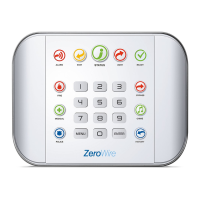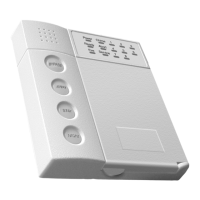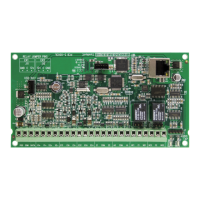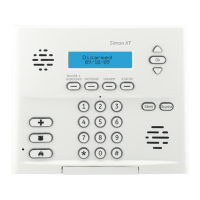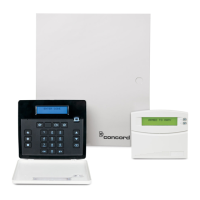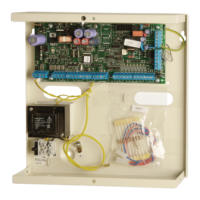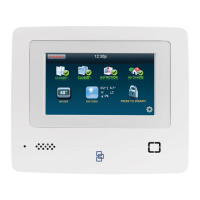Do you have a question about the Interlogix ZEROWIRE ZW-6404 and is the answer not in the manual?
Legal disclaimer regarding product use and potential damages.
Critical warnings about system limitations, risks, and third-party dependencies.
Details on product warranties provided and excluded.
General statement about document accuracy, changes, and liability.
Specifies the proper purpose and limitations for product usage.
Advises of hazards that could result in injury or loss of life.
Advises of possible equipment damage.
Provides important information or suggests ways to avoid loss of time/effort.
Highlights key capabilities and advantages of the ZeroWire system.
Lists the components included with the ZeroWire system.
Describes the function of each key, light, and button on the ZeroWire panel.
Illustrates and labels the various connectors and components on the rear of the unit.
Provides definitions for important terms used throughout the manual.
Lists all necessary tools and components for installation.
Guidance on selecting an optimal and interference-free installation site.
Instructions on how to detach the wall mounting bracket.
Steps for installing the optional cellular radio module.
Procedure for connecting the ZeroWire to a power source.
Instructions to reset the installer account to default settings.
Method to verify the cellular signal strength on the keypad.
Steps for installing an external antenna to improve signal.
Final steps to finish the physical installation process.
Guide on how to install the backup battery pack.
Instructions for mounting the ZeroWire unit securely on a wall.
Guide for placing the ZeroWire on a flat surface using a desk stand.
Procedure to restore the ZeroWire to its original factory settings.
Choosing between Wireless LAN, Wired LAN, or 3G Cellular for network connectivity.
Step-by-step guide to connect the ZeroWire to a WiFi network.
Instructions for connecting the ZeroWire using an Ethernet cable.
Guide for configuring the cellular radio for backup reporting.
Explains how different user types affect menu visibility and permissions.
Steps to download and set up the mobile application.
How to navigate and utilize the features of the mobile application.
Key security settings to modify for user accounts and access.
Solutions for problems like no IP address or WiFi visibility.
Initial setup and zone testing using the ZeroWire keypad.
General instructions for handling and preparing detectors.
Tips for optimal detector placement and signal strength.
Procedure to add detectors to the system.
Explanation of zone types and their configuration.
Details on default zone types and their options.
How to assign custom names to zones using voice or text.
Steps for recording custom voice names for zones.
Method to check the wireless signal strength of installed zones.
Procedure to delete a zone from the system.
Guide to add new users and their associated keyfobs.
How to assign roles (Master, Standard, Arm Only) to users.
Steps for recording custom voice names for users.
Procedure to delete a user from the system.
Guide to associate a keyfob with a user.
Procedure to remove a keyfob from the system.
Overview of advanced settings accessible via the web server.
General instructions for handling and preparing detectors.
Tips for optimal detector placement and signal strength.
Procedure to add zones to the system via the web server.
Performing zone tests through the web interface.
Steps to set up email notifications for system events.
How to adjust the audible output volume.
Enabling or disabling voice prompts for system status.
Controlling the level of detail in voice menu descriptions.
Adjusting the brightness of the display's backlight.
Procedure to manually set the system's time and date.
Configuring delay times for arming/disarming areas.
Overview of the four types of system tests to perform.
Verifying detector functionality by simulating events.
Testing the audible alarm siren.
Checking the status and functionality of the backup battery.
Verifying the system's ability to send alarm reports.
How to access and listen to past system events and alarms.
Diagram illustrating system features and their dependencies.
Hierarchical structure of the ZeroWire's web server menus.
Steps to integrate cameras with the mobile app.
Solutions for common issues with camera connectivity and operation.
Procedure to integrate Z-Wave devices into the system.
Steps to remove Z-Wave devices from the system.
Integrating ZeroWire into an existing Z-Wave network.
Detaching ZeroWire from a Z-Wave network.
Making ZeroWire the main Z-Wave controller.
Transferring ZeroWire's primary controller role to another device.
Steps to replace a malfunctioning Z-Wave device.
Procedure to remove a non-responsive Z-Wave device.
Customizing programmable buttons for specific actions.
Synchronizing user PINs between ZeroWire and Z-Wave door locks.
Settings for enabling and disabling wired inputs and zone doubling.
Programming outputs to trigger sirens, strobes, or other devices.
Modifying how system events are reported to monitoring centers.
Steps to install and connect the DLX900 management software.
Solutions for common issues when connecting DLX900.
Procedure for updating ZeroWire firmware via the software.
Alternative method for firmware updates using a USB tool.
Explanations of messages related to system power, battery, and communication.
Meanings of messages related to arming states and readiness of areas.
Explanations of zone-specific messages (alarm, bypass, trouble).
Descriptions of common error messages encountered in the system.
List of words available for voice customization of zone names.
Overview of the ZeroWire's hardware and performance specifications.
Legal disclaimer regarding product use and potential damages.
Critical warnings about system limitations, risks, and third-party dependencies.
Details on product warranties provided and excluded.
General statement about document accuracy, changes, and liability.
Specifies the proper purpose and limitations for product usage.
Advises of hazards that could result in injury or loss of life.
Advises of possible equipment damage.
Provides important information or suggests ways to avoid loss of time/effort.
Highlights key capabilities and advantages of the ZeroWire system.
Lists the components included with the ZeroWire system.
Describes the function of each key, light, and button on the ZeroWire panel.
Illustrates and labels the various connectors and components on the rear of the unit.
Provides definitions for important terms used throughout the manual.
Lists all necessary tools and components for installation.
Guidance on selecting an optimal and interference-free installation site.
Instructions on how to detach the wall mounting bracket.
Steps for installing the optional cellular radio module.
Procedure for connecting the ZeroWire to a power source.
Instructions to reset the installer account to default settings.
Method to verify the cellular signal strength on the keypad.
Steps for installing an external antenna to improve signal.
Final steps to finish the physical installation process.
Guide on how to install the backup battery pack.
Instructions for mounting the ZeroWire unit securely on a wall.
Guide for placing the ZeroWire on a flat surface using a desk stand.
Procedure to restore the ZeroWire to its original factory settings.
Choosing between Wireless LAN, Wired LAN, or 3G Cellular for network connectivity.
Step-by-step guide to connect the ZeroWire to a WiFi network.
Instructions for connecting the ZeroWire using an Ethernet cable.
Guide for configuring the cellular radio for backup reporting.
Explains how different user types affect menu visibility and permissions.
Steps to download and set up the mobile application.
How to navigate and utilize the features of the mobile application.
Key security settings to modify for user accounts and access.
Solutions for problems like no IP address or WiFi visibility.
Initial setup and zone testing using the ZeroWire keypad.
General instructions for handling and preparing detectors.
Tips for optimal detector placement and signal strength.
Procedure to add detectors to the system.
Explanation of zone types and their configuration.
Details on default zone types and their options.
How to assign custom names to zones using voice or text.
Steps for recording custom voice names for zones.
Method to check the wireless signal strength of installed zones.
Procedure to delete a zone from the system.
Guide to add new users and their associated keyfobs.
How to assign roles (Master, Standard, Arm Only) to users.
Steps for recording custom voice names for users.
Procedure to delete a user from the system.
Guide to associate a keyfob with a user.
Procedure to remove a keyfob from the system.
Overview of advanced settings accessible via the web server.
General instructions for handling and preparing detectors.
Tips for optimal detector placement and signal strength.
Procedure to add zones to the system via the web server.
Performing zone tests through the web interface.
Steps to set up email notifications for system events.
How to adjust the audible output volume.
Enabling or disabling voice prompts for system status.
Controlling the level of detail in voice menu descriptions.
Adjusting the brightness of the display's backlight.
Procedure to manually set the system's time and date.
Configuring delay times for arming/disarming areas.
Overview of the four types of system tests to perform.
Verifying detector functionality by simulating events.
Testing the audible alarm siren.
Checking the status and functionality of the backup battery.
Verifying the system's ability to send alarm reports.
How to access and listen to past system events and alarms.
Diagram illustrating system features and their dependencies.
Hierarchical structure of the ZeroWire's web server menus.
Steps to integrate cameras with the mobile app.
Solutions for common issues with camera connectivity and operation.
Procedure to integrate Z-Wave devices into the system.
Steps to remove Z-Wave devices from the system.
Integrating ZeroWire into an existing Z-Wave network.
Detaching ZeroWire from a Z-Wave network.
Making ZeroWire the main Z-Wave controller.
Transferring ZeroWire's primary controller role to another device.
Steps to replace a malfunctioning Z-Wave device.
Procedure to remove a non-responsive Z-Wave device.
Customizing programmable buttons for specific actions.
Synchronizing user PINs between ZeroWire and Z-Wave door locks.
Settings for enabling and disabling wired inputs and zone doubling.
Programming outputs to trigger sirens, strobes, or other devices.
Modifying how system events are reported to monitoring centers.
Steps to install and connect the DLX900 management software.
Solutions for common issues when connecting DLX900.
Procedure for updating ZeroWire firmware via the software.
Alternative method for firmware updates using a USB tool.
Explanations of messages related to system power, battery, and communication.
Meanings of messages related to arming states and readiness of areas.
Explanations of zone-specific messages (alarm, bypass, trouble).
Descriptions of common error messages encountered in the system.
List of words available for voice customization of zone names.
Overview of the ZeroWire's hardware and performance specifications.
| Model | ZW-6404 |
|---|---|
| Wireless Protocol | Z-Wave |
| Frequency | 908.42 MHz |
| Compatibility | Z-Wave certified controllers |
| Sensor Type | Magnetic Contact |
| Operating Temperature | 32°F to 120°F (0°C to 49°C) |
| Type | Door/Window Sensor |
| Range | Up to 100 feet, open air, line of sight |
| Battery Life | 3-5 years |
